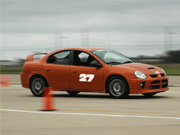
Autocross/Solo (Entry-Level)

Autocross (Also known as "Solo" and "Autoslalom") is a form of time-trial racing run with cars ranging from stock production cars to purpose-built race cars. Within classes that match vehicle type and horsepower to each other, racers negotiate a race course one or more at a time (not side-by-side, but at intervals) while being timed. The emphasis is placed on developing driver skill, having fun and keeping costs low.
A wide variety of production vehicle types and configurations are used at the entry level of the sport. Almost any daily-driven vehicle qualifies for autocross with the exception of high roll-center vehicles which can easily roll over in sharp turns.
Racing is generally on parking lots, kart tracks, road course circuits, and dirt circuits and is widespread throughout the Americas, UK and Australia. There is also a type of off-road racing called Autocross sanctioned by the FIA in Europe.
Autocross/Solo (Entry-Level) Contents
| Power and Weight Stats | |
| Horsepower (Typical Range) | 115-300 |
| Race Weight (Typical Range) | 1225-1634 kg 2700-3600 lb |
Design and Construction
Race Car Models of This Type
Stock or near-stock production vehicles. Because each vehicle is categorized into its proper class, vehicles race on a level playing field.
Build Your Own Entry-Level Autocross/Solo car
Knowledge Level
At the entry-level, it is useful to have a basic knowledge of vehicle handling and dynamics. Due to the limitations placed on vehicle modification, the focus should be on increasing driving skills and optimizing setup of the vehicle. There are great books (some specifically for Autocross) to assist you in maximizing your overall performance. The knowledge you gain will reward you with the best results possible when you move on to modifying your vehicle further.
Design Challenges
Where possible, do your homework before purchasing components. Researching the available options is key when dealing with off-the-shelf modifications.
Suspension: Entry-level Autocross does not permit modification to the suspension, but consideration should be given to the unsprung weight at each corner of the vehicle (Wheels, tires). If some leeway is allowed by the regulations, wheels, tires and brakes can be optimized. By reducing weight, utilizing the widest available tire for the stock wheel size, and maximizing brake friction the vehicle's handling performance can be greatly increased. If street-legal (ie. DOT) racing tires are permitted, they will also considerably enhance grip. Adjustable shocks may also be permitted and can assist in tuning the handling.
Chassis: In entry-level Autocross, safety modifications such as a roll cage are permitted and can provide additional chassis torsional rigidity which makes handling more consistent. However, at the entry-level, these modifications will probably be of higher value for safety than for performance.
Powertrain: Powertrain modifications at the entry-level usually consist of freer flowing air filters and mufflers, spark plugs.
Aerodynamic: Usually no changes in aerodynamics are permitted at the entry-level, and given the top speeds achieved (Usually under 100 km/h or 60 mph), they would be of little value anyway.
Safety: Adding a roll cage provides a measure of safety that a stock vehicle does not provide. It will also add a measure of confidence for the driver, who will not be afraid to push as hard as they can in the knowledge they are protected. If a roll structure is not available off-the-shelf, however, it will need to be designed and fabricated, which will require some steel design and welding work (This can be done by speed or metal fabrication shops)
A racing seat with a multi-point harness might also be considered to enable the driver to feel the car more accurately, maintain seating position in cornering and secure the driver fully in the case of a rollover.
If you intend to race under a sanctioning body, always read and understand the regulations of your chosen racing class before designing or building any race vehicle.
Design Resources
Learn the basics about race cars and race car design from our free online knowledge series
Download our free race car design aids to assist you designing your race vehicle.
In-depth books and learning resources we recommend for entry-level Autocross car design.
Join our forum to ask and find answers to your entry-level Autocross car design/construction questions.
Construction Challenges
Most components permitted for entry-level Autocross are bolt-on type components and therefore are within the mechanical skills of most people. For roll cages that must be custom fabricated, there is the additional requirement of fitting it into a production vehicle and of locating mounting points that do not compromise the uni-body structure.
Build Costs
Due to the limited modifications imposed by most entry-level Autocross classes, costs are usually very low. Even if replacing the wheels, tires, brakes and installing roll structures, the costs are still relatively low compared to other race car types.
Build Effort
Build effort is also very low due to the bolt-on nature of most changes to the vehicle.
Racing Cost
Consumable costs are low, with the highest expense likely coming from the purchase of street-legal racing tires.
Transportation and Support Equipment
The vehicle can be driven to the track and support equipment can be carried in the vehicle.

